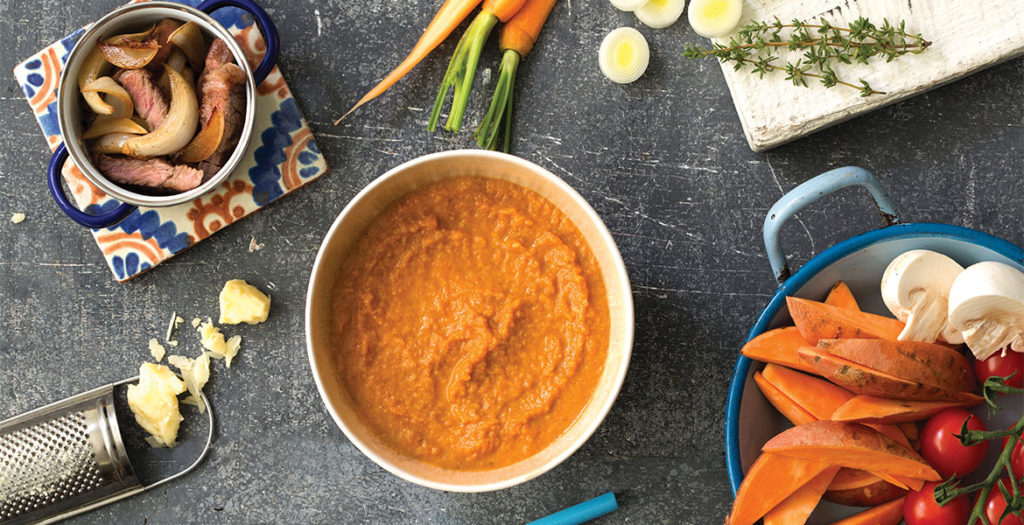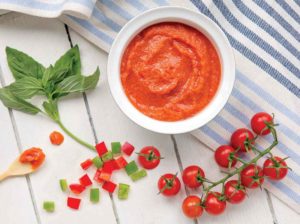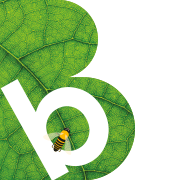
Sponsored post
We take a whistle stop tour of first foods
What is weaning?
Weaning means introducing real food alongside your baby’s milk. It’s also called complementary feeding, which I like, as weaning is not about a sudden transition to three meals a day but a gentle introduction of a range of foods. The aim is to wean your little one slowly off their milk, onto family foods. In the UK, we are advised to start around six months, as this is around the time when a baby’s digestive system has developed enough to tolerate solids.
Don’t forget the milk
Remember that your baby’s breastmilk will continue to be an important part of their diet for the first year of their life, providing most of the nutrients and calories a baby needs. Think of those first tastes of food as more of an experience, a game of trying new and exciting tastes. Don’t worry about the amount of food, or the speed at which they are accepted.
Is your baby ready for food?
Signs your baby is ready are:
- He can hold his head up and keep an upright position
- He has good coordination, can look at food, grab it and put it in his mouth.

What and when
There’s no single best food to start with. Vegetables are great, as savoury tastes can take a while to be accepted. Try broccoli, butternut squash, carrot, cauliflower, courgette, parsnip, potato, pumpkin and sweet potato.
You can offer these as a purée, a soft finger food, or a combination of both. Finger foods are an important part of weaning but do whatever works best for your family. You can also introduce the delicious flavours of herbs and spices to your baby’s repertoire from early on. Try adding cinnamon to apple, mint to peas and spinach, or basil to sweet potato.
 Introducing lumps
Introducing lumps
You can start introducing texture to your baby’s food pretty early on, once they are happy with simple purées and have successfully learned to suck from a spoon. This varies from one to baby to another, with some taking a little longer than others. This is quite normal and it is likely to be a few weeks after they have had their first solid food. It’s important not to delay moving onto textured foods, as it may delay your baby accepting a wider variety of foods later on. Lumps are an important stage in your child’s progress towards feeding himself and sharing in all your family mealtimes.
Adding lumps should be a gradual process; you can either go straight onto finger food, or start with small, soft overall lumps – think mashing with a fork over blending. Chewing is a big milestone, so don’t expect it to happen right away and it is a messy process to learn, so be patient and you’ll soon start to see progress.
Two top tips:
- While you’re mashing food, why not give him a piece of the food to chew on. Giving him large chunks of soft cooked vegetables, fruit or soft meats or fish (watch for bones), is a great way for him to practice his pincer grip and hand-eye coordination.
- Avoid surprise lumps; they can be off-putting for babies. Try to stick to overall mash, or keep lumps separate and give pasta pieces or chunks of cooked vegetable separately to the purée.
Mealtime memos
It doesn’t matter what time of day you offer food to your baby. You need to have time and not be in a rush. It is also a good idea to introduce food in between milk feeds, so they are neither starving, nor full from a feed.
To start, either sit your baby in a high chair at the table next to you, or feed him on your knee – whichever feels more natural and comfortable for both of you.
Your baby may only take a teaspoon of food to begin with and he may take even less. Try not to worry about the quatity; neither should you worry if he doesn’t seem interested at all. He may not be ready, or he may just not be hungry. Just take the food away and try another time.
If your baby doesn’t seem interested in food, avoid using distractions to try to get him to eat, as he just may not be hungry. Simply offer food at another time that suits you both, remembering that he is still getting most of the essential nutrients he needs from his breastmilk.
Don’t be surprised if your baby initially spits the food out and appears to dislike it. New tastes and textures take a little while to get used to but don’t worry – babies soon learn to love a large variety of textures and flavours.
You can mix and mash different types of fruit and vegetables together but it’s also a good idea to offer those ingredients separately, so that your baby knows what a more bitter, more savoury or a sweeter flavour tastes like. Try giving steamed broccoli spears for your baby to gum on, while you whizz up some kale or spinach and peas together. Kept trying different combinations.
Always stay with your baby during his mealtimes and never leave him alone in a highchair at any time.
Finger food ideas
Try sticks of steamed, boiled or roasted vegetables like sweet potato, carrot, potato, broccoli or cauliflower.
Smear apple wedges with coconut oil, sprinkle with cinnamon and cook
in the microwave until very soft. Don’t forget that raw apples and other hard foods like carrots are a choking hazard.Offer a banana, with the skin partially removed. As your baby eats the banana, keep peeling the skin further.
Soft fruit like very ripe pear, kiwi, mango or papaya can be cut into wedges or discs – simple.
Roast different vegetables like carrots, sweet potatoes, butternut squash, red peppers and courgette. Cut them in long chunks or large, round pieces that are easy to grab with little hand. Great for grabbing!

 Introducing lumps
Introducing lumps